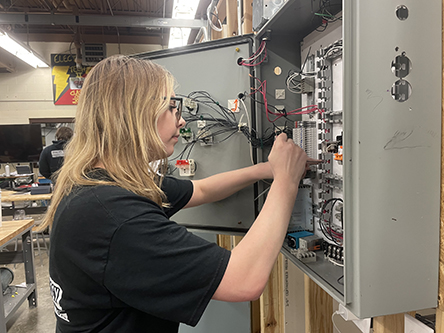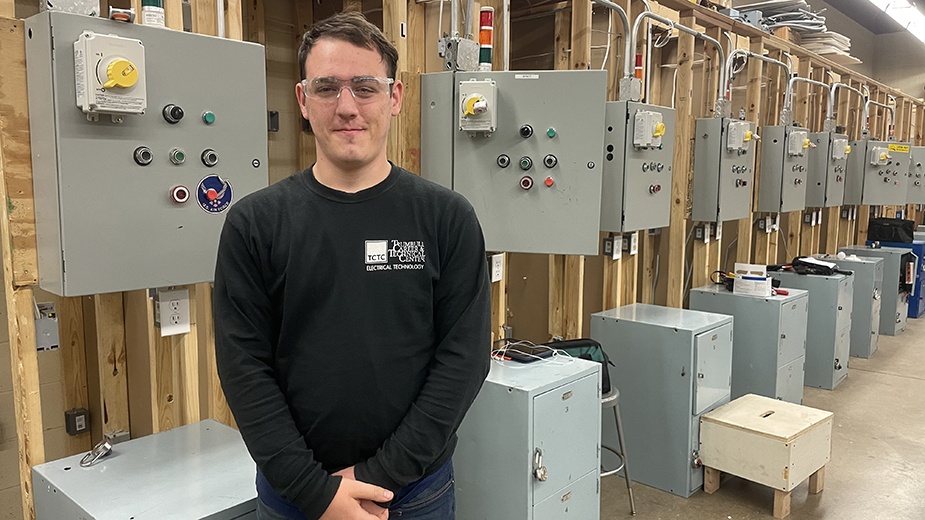YOUNGSTOWN, Ohio – After seeing his brother work as an aviation maintenance technician, Sam Adams was inspired to follow his path.
Adams, a Howland student, is studying in the electrical technicians program at Trumbull Career and Technical Center and works at Guitner Electrical Services of Warren the weeks he’s not in class.
TCTC’s week on and week off program allows electrical technician students to have a full-day immersion work experience with partner businesses.
Adams plans to continue his training in a 16-month program at the Pittsburgh Institute of Aeronautics after he graduates. He wants to learn avionics, the electrical-based parts of aircrafts that include automation, communication and navigation equipment. He hopes one day to work for American Airlines.
“I came to the [TCTC] electrical program to prepare me for it and try to get me set up so I can have a head start,” Adams says.

Adams is who the TCTC electrical technician instructor, Mark Taylor, calls one of his legacy students, one who has had a brother, sister or cousin find success after coming through the program.
Taylor brings 33 years of industrial electrician experience working for GM in Lordstown to help students learn skills relevant to the field. High voltage, heater house maintenance, line conveyor controls – all fall under what he worked on at the plant.
“One day you were putting up a building and wiring it like a house and the next day you were wiring a conveyor,” Taylor says, “It’s so diverse.”
The class is maxed out at 25 students per grade with a waiting list triple that capacity. Taylor teaches the basics of residential, commercial and industrial electrical work. The curriculum includes the National Electric Code and the safety skills essential to work in a field where mistakes can cost a life.
Taylor believes in creating partnerships with local businesses, training programs and unions. He wants employers to consider judging student projects at the school, giving the students a chance to impress them and Taylor a better idea of what they seek in employees. He has an advisory committee with representatives from local companies that helps him hone the program.
“I want to put as many feathers in their cap as possible. Everything they learn – I want them to be able to walk in [to their next opportunities] with as many feathers, as many advantages as possible,” Taylor says of his students.

TCTC has pre-apprenticeship agreements with VEC Inc. and the Mahoning Valley Manufacturers Coalition. Students who do well at TCTC can get into the International Brotherhood of Electrical Workers union.
“Everyone says the same thing: ‘Will they show up for work?’ ‘Will they show up on time?’ ‘Can they pass a drug test?’ And, ‘Can they leave their phone in the car?’ If so, we’ll hire them tomorrow,’ ” Taylor says.
Students who graduate from the program this spring have lined up opportunities through the Youngstown Area Electrical JATC lineman-training program, the PIA, and several partner employers. Three are heading to college to study electrical engineering.
Taylor believes the high academic standards and programs like College Credit Plus and honors classes available at TCTC “rival any high school in Trumbull County.”
One former student is attending Youngstown State University and works for Ajax Magnethermic, which reimburses him a percentage of his tuition based on his grades, up to 100% per A.
Demand for Electricians
Taylor does not see demand for students from electrical training programs ending anytime soon.
“Post-Covid, everyone was looking for someone. Now it has slowed down and they are getting picky,” Taylor says, adding there is plenty of work.
Electricity intensive data centers, nontraditional power generation and charging stations for vehicles are just a few of the ways electricians will remain relevant and pursue jobs that are in demand.
At Mahoning County Career and Technical Center, students are helping Canopy Solar install solar panels on the roof of the school’s $1.2 million energy workforce-training center, which opened last fall. The new building has allowed instructor Kory Cooper to add more programs to the electrical program, which is maxed out at 25 students per grade with a waiting list for the past three years.
Students learn about solar connectivity, transforming DC voltage into AC voltage before adding it to the grid, battery savings and efficiency of panels.
“They actually can see what it’s like to install that. And then, when they’re done, they’ll be able to see the efficiency and how it works and know what’s behind all of that work,” Cooper says.
A solar car charger also is being installed at the training center.
MCCTC also has added lineman pole training to augment residential, commercial, industrial and specialty electrical training.
“I try to expose them to five or six different facets of the industry,” Cooper says, noting specialty electrical training includes low-voltage opportunities such as installing security systems and internet. “We try to touch on all of it to give the kids exposure and help direct them in the way they want to go.”
Cooper says it seems like the school keeps adding career pathways and new electrical-related careers each year, including fiber-optic installation, which is expanding locally.
“I’ll bet you in the last five years the need for electricians has doubled in this valley,” Cooper says.
And many are not waiting to graduate to get broader experience. This year, three-quarters of Cooper’s students are doing early work, attending school one day per week and working the other four.
But Cooper says it’s also important to focus on the soft skills, ensuring the students are employable.
“Most have already landed a job as soon as they graduate, which has been a real blessing, and seems to be going up every year,” Cooper says. “My goal is to make sure each kid who wants to be placed, has found their niche to have a job opportunity or an apprenticeship before they graduate.”
MCCTC also teams up with the Western Reserve Independent Electrical Contractors program, the IBEW and industry partners such as VEC in Girard, for training programs and work opportunities.
“The career field is unlimited,” Cooper says. “It just depends on what they want to do. The median salary around here is really good for skilled trades. If we’re getting half the work that’s proposed right now, we’re not going to have enough. And we’re going to be looking elsewhere at different states to sign the book and different traveling electricians to come through and help us handle the work that’s coming through here.”
Large projects like the Ultium Cells plant meant the Mahoning Valley had to search for electricians from elsewhere, including traveling electricians who follow big-dollar projects, according to Cooper.
“Being union, you could travel to any of the 50 states and Canada with your card and sign any of their books,” Cooper says. “With all that training, you are able to take that with you and go wherever your family is or wherever you need to go to better your situation.”
Training Enough Students?
The Ultium plant was a bit of a challenge,” says Eric Davis, training director at the IBEW local in Warren. “We certainly don’t have as bad of a problem as other parts of the country.”
The U.S. Bureau of Labor Statistics reports there were 712,580 working as electricians nationwide in May 2023 and they had a mean annual wage of $67,810. The vast majority work as building equipment contractors. Ohio was employing 24,430 in May 2023, fifth most in the United States.
The number of electricians is expected to rise by 9% between 2020 and 2030, according to the Bureau of Labor Statistics. Baby boomers and early Generation X are retiring, leading to concerns nationally about the numbers of trained electricians long term.
Some of that projected increase is in EV charging stations, for which Davis says he began training 15 years ago with some of the IBEW instructors. Every apprentice going through the courses learns how to install them, and calculate the capacity for a home charger. The IBEW offers a refresher course for journeyman electricians.
“We thought that would take off quite a while ago and it didn’t,” says Davis, who noted Ohio is one of the states that has funds to build charging stations along interstates and reportedly is making progress. Eventually, that work will get here.
Ed Emerich of IBEW Local 64 in Boardman points out it is not just about getting enough applicants, but also getting enough quality applicants.
“Not so much in Mahoning County or this part of Ohio, [but] there’s a gap in the workforce. We are pretty much mandated by our local, regional and national organizations to boost our numbers to fill those positions so that when the work does happen we have qualified workforce,” he says.
It takes three to five years to get the apprenticeship training, depending on the type of electrical work – residential or commercial – but Emerich notes that does not replace the knowledge someone with 20 or 30 years has built up through experience.
“We want people to be as efficient and proficient as possible and while the work might not be there right at the moment, we have to prepare for the inevitable future when it does happen so that work shortage is either non-existent or minimal,” Emerich says.
“Once the battery plant slowed down, some of the other projects that were slated to start have been slow getting going,” Davis says. “We’re certainly optimistic for the future and that does not stop us to continue to recruit and find the best candidates available.”
And with everything that is happening across the country – the need to build new grid capacity, replace aging infrastructure and the push for renewable energy – even if there isn’t a large project in the Mahoning Valley, projects elsewhere can mean opportunities for local electricians.
“All of the projects happening in the Columbus area and west of Columbus are so big that there will be people from all over North America who will be going to work at those construction sites. So you have to look at things through a macro lens, not a micro lens,” Emerich says.
How to Enter the Field
While there is never a wrong time to apply, the winter months are better because new apprentices start the program in May. The minimum requirement is a high school diploma with algebra, according to Emerich, but applicants also take an aptitude test and are interviewed with the residential and commercial/industrial boards.
Students from a program like those offered at MCCTC or TCTC have the experience and knowledge that gives them a leg up, when applicants are placed on a ranked list. The age requirement is 18, with the union taking both recent high school graduates and those seeking a career change.
Davis states a willingness to learn is a requirement and some mechanical ability is helpful.
Two nights a week, September through May, the apprentices take three-hour classes. During the days, they work in the field with a trained electrician and earn money while getting 8,000 hours.
That said, they will not add more people to the apprenticeship rolls if there is insufficient work.
“If you’re going to learn a good portion of the trade out in the field and we don’t have a job to send you to, an opportunity for that on-the-job training, you’re leaving a big component of the training out and it then takes longer than five years, potentially,” Emerich says.
“Construction really is a cyclical business,” Davis says. “It certainly has its ebbs and flows and peaks and valleys.
“Locally, we seem to do pretty well having the people we need when work is plentiful, when construction is busy.”
Pictured at top: Sam Adams, a TCTC student from Howland, is following in his brother’s footsteps by going through the electrical technology program at the school. He will follow up his education with the Pittsburgh Institute of Aeronautics training program.
